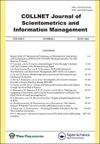A bibliometric analysis of artificial intelligence publications from 1991 to 2018
IF 0.8
Q2 INFORMATION SCIENCE & LIBRARY SCIENCE
COLLNET Journal of Scientometrics and Information Management
Pub Date : 2020-07-02
DOI:10.1080/09737766.2021.1918032
引用次数: 15
Abstract
This study aimed to analyze the characteristics of artificial intelligence-related publications in Science Citation Index Expanded (SCIEXPANDED) from 1991 to 2018. The analyzed aspects covered distribution of annual publications, citations per publication, journals, Web of Science categories, countries, institutions, as well as research foci and their trends. A total of 13,251 artificial intelligence-related articles were found. Articles were published in a wide range of journals and Web of Science categories. The United States took the lead position in total, single country, international collaboration, and first, corresponding, and single author articles as well as citations per publication among 119 countries. Chinese Academy of Sciences in China, Islamic Azad University in Iran, and Massachusetts Institute of Technology (MIT) in USA were the three most productive institutions. MIT had higher citations per publication. An international collaborative article by authors from Canada, the United States, and Switzerland was the most frequently cited article with the most total citations from Web of Science Core Collection since publication through the end of 2018. Results from word cluster analysis showed that models, neural networks, learning, and prediction were the most popular topics and features, classification, and optimization might be focus in artificial intelligence research.1991年至2018年人工智能出版物的文献计量分析
本研究旨在分析1991年至2018年《科学引文索引扩展》(SCIEXPANDED)中人工智能相关出版物的特征。分析的方面包括年度出版物的分布、每份出版物的引文、期刊、科学网络类别、国家、机构以及研究重点及其趋势。共发现13251篇人工智能相关文章。文章发表在各种各样的期刊和网络科学类别上。在119个国家中,美国在总量、单一国家、国际合作、第一、通讯和单一作者文章以及每份出版物的引用量方面处于领先地位。中国的中国科学院、伊朗的伊斯兰阿扎德大学和美国的麻省理工学院是生产力最高的三个机构。麻省理工学院的每份出版物引用次数都更高。加拿大、美国和瑞士作者的一篇国际合作文章是自2018年底发表以来,科学网核心收藏中引用次数最多、引用次数最多的文章。聚类分析结果表明,模型、神经网络、学习和预测是最受欢迎的主题,特征、分类和优化可能是人工智能研究的重点。
本文章由计算机程序翻译,如有差异,请以英文原文为准。
求助全文
约1分钟内获得全文
求助全文
来源期刊

COLLNET Journal of Scientometrics and Information Management
INFORMATION SCIENCE & LIBRARY SCIENCE-
自引率
0.00%
发文量
11
 求助内容:
求助内容: 应助结果提醒方式:
应助结果提醒方式:


